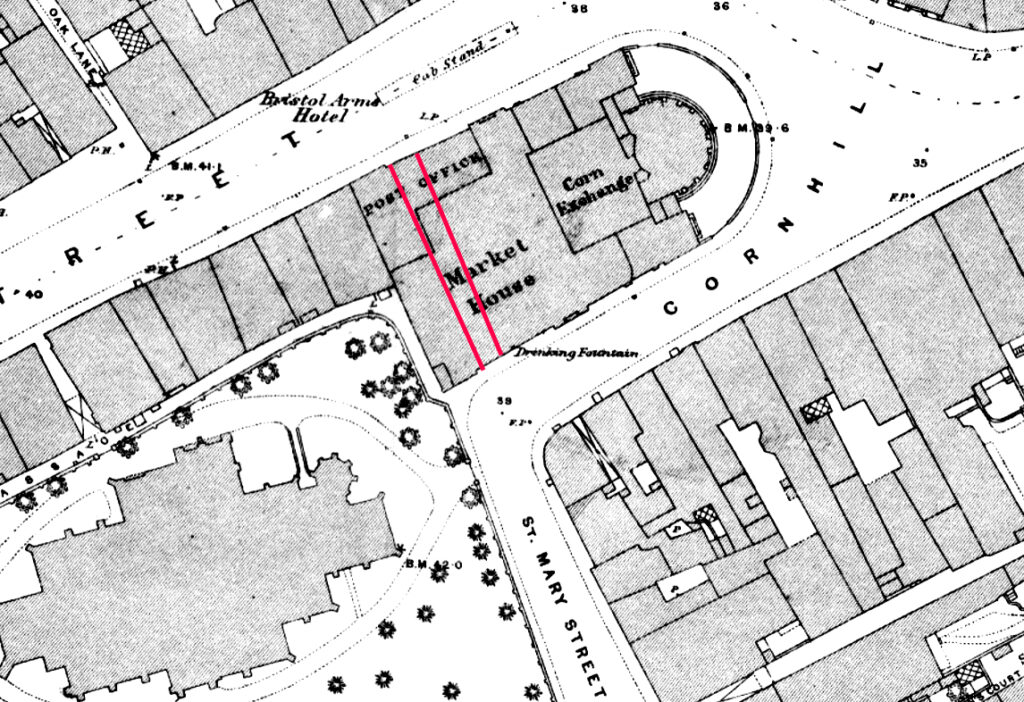

The Cockmoyle prison, and the lane in which it stood, known as the Bow (after the buildings built above it at each end) somewhere in a complex of buildings demolished in 1778 to make way for the first phase of the Cornhill market house. The Gaol was moved to Fore Street.
Historical Notes
Abstract of Sources in the Somerset Heritage Centre
Somerset Heritage Centre D/B/bw/2231 (1575) Describes a property bounded by the street going towards the church on the south and the lane going to the Cockmoyle prison on west. In later documents (c.1770) this building is described as a property formerly called the Bell, bounded on west with the lane leading under the Bow which used to lead to prison called the Cock Moyle and on south with street leading to the church, 1575-1770. This is also possibly D/B/bw/CL/96 (1570-1760) House with a vault underneath, bounded on the south with street from church to Bridge, on west with churchyard, on east with lane leading to Little Bow; house newly built between 1672-1676
D/B/bw/2177 (1605) Describes a property called the Bakehouse on the south side of High Street and part of a court adjoining, which is bounded by a lane on its west side leading to the Cockmoyle. This lane is likely to be the ‘Upper Bow’, described in D/B/bw/CL/22 (1712, 1776), a house (possibly the same one as above) on south side of High Street adjoining and partly built over a lane called the Upper Bow, as well as the little Cockmoyle or gaol near the Upper Bow. This is also possibly the property described in D/B/bw/CL/18, House over the Bow described as ‘ruinous tenement known as Old Tolsey’ 1581 and ‘formerly Old Tolsey’ to 1654. This also appears in D/B/bw/1422 (1578) shop called The Tolzey/ a house under the Bow.
Further notes
Taunton Courier and Weston Advertiser 19th June 1935, by W.G. Willis Watson
‘it is recorded at the time of the Monmouth rebellion, the prison was then an ale-house, for Mary Pillecke, wife of John Pillecke, of the parish of Bridgewater, husbandman, deposed that “before the time that the late Duke of Monmouth did come into England by way of rebellion, Anstice Dawes, of Bridgwater, widow, did possess a certain ale-house called the Cocke-moyle, seytuate in Bridgwater, within which said how’s the common prison of the said Burrough was kept, and sayth that complainant, Thomas Nutt, was Keeper of the said prison within the said house. Thomas Venn, of Bridgwater, gentlemen, aged 60, “doth believe that the bailiffs of the burrow of Bridgewater which are elected every year to set and let for one year the dwelling-house called the Cockmoyle used for common prison for the said burrow to the complainant for that year, but he cannot tell whether any distinction was made between the prison and the cellers and other parts of the said house, but hath heard there is 40 shillings yearly paid to the bayliffes for the new buildings belonging to the said Cockmoyle and the said defendant, Anstice Daws, kept and employed the said house called the Cockmoyle until Michaelmas, 1684, and some short tyme after there was a Turne over of Gaol of the said burrow, and then the said Cockmoyle prison were possesst and enjoyed by the complainant, who was reputed the master and owner thereof.”
Taunton Courier, and Western Advertiser 16 September 1939, by H.W Kille
Moyle or Moil is an old word for mule, and is defined in old dictionaries as drudgery, to drudge like a mule. How it comes to be linked up with cock is difficult to say, but I am inclined to think that the supposition mentioned last week, that ‘cock-moyle’ has some reference to cock-crow and labour may not be so very farfetched. The word cock being practically synonymous with sunrise, it may have been associated with moyle in some slang phrase for jail.
The common prison at Minehead was also called the Cockmoyle.
Dunning: Victoria County History
A lock-up called the Cockmoyle prison was mentioned in 1575. (S.R.O., D/B/bw 2231) It was later said to be part of an inn of the same name, and in 1687-8 was called the borough bridewell. (P.R.O., E 134/3 Jas. II East./26.) The lock-up was evidently on an upper floor over a lane between High Street and the churchyard, since it was known as the higher prison in the 17th century and Upper Bow in the 18th. (S.R.O., D/B/bw 1617, 1686.) In 1729 the quarter sessions established a bridewell for the borough and parish, probably an extension to the town’s prison, and set up a whipping post there. (Ibid. 2/1/1 (26 Aug. 1729))
MKP 25/10/2020
